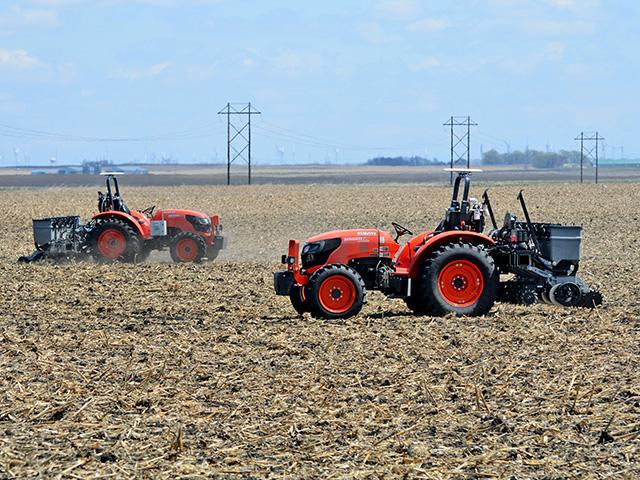Autonomous Planting Revs Up
Technology - Autonomous Planting Revs Up
Three tractors and planters seeded more than 500 acres of soybeans at a northwest Iowa farm with no one at the wheel.
Sabanto, a Chicago-based robotic farming company, helped Bellcock Farms plant using remote-controlled utility tractors, each pulling five-row planters. Several other farmers in Illinois and Iowa have also hired the company to provide robotic planting help this year.
Autonomous farming has moved from the proof-of-concept stage to commercial reality for the company.
"This is the real deal ... it will change agriculture," says Sabanto co-owner Craig Rupp. "We've gone from one tractor and planter to multiple machines operating remotely at the same time."
Sabanto got its feet wet last year (June 2019 Progressive Farmer) planting several thousand acres of soybeans throughout the Midwest with one remote-controlled tractor and planter. Rupp and co-owner, Kyler Laird, tested equipment and worked on software, networking, logistics and other issues to scale up autonomous operations in 2020.
The company's vision to solve agriculture's labor shortage with autonomous technology is being realized, Rupp explains.
"This is still a work in progress; it's hard to do," he adds. "However, I do believe this will be the solution to the lack of labor in [row-crop] agriculture."
Justin Bellcock says his family is fortunate they currently have enough help for their row-crop, turkey and crop-input businesses. However, he knows that may not always be the case.
That's why the Bellcocks hired Sabanto to plant a portion of their soybean acres this spring. They also were a Sabanto test site in 2019.
P[L1] D[0x0] M[300x250] OOP[F] ADUNIT[] T[]
"Labor shortages in farming will only get worse," Bellcock says. "There may be a day when we don't have the help, so I want to see this technology succeed.
"Maybe it's not financially feasible or the labor isn't available to have a second or third planter to get crops in the ground quickly," he continues. "[Sabanto] is another avenue."
Rupp claims the company's custom-farming rates are competitive with state averages. The 2020 Iowa Farm Custom Rate Survey pegs average planting rates at $20.40 to $23.40 per acre or more depending on equipment and technology.
SMALL BUT MIGHTY
Bellcock was impressed last year with Sabanto's remote-operated 235-hp JCB Fastrac and 18-row Harvest International planter. The unit was capable of planting about 500 acres in 24 hours of continuous operation.
By today's standards, the three 60-hp Kubota M5660SU tractors with five-row Harvest International planters traversing Bellcock's fields weren't an impressive display of power and size. But, watching the driverless units work together and the technology making it happen certainly got Bellcock's attention. "This is the future of agriculture," he claims.
The three small units can plant almost the same number of acres during a 24-hour period as the bigger tractor and planter used last year. Rupp chose small implements this year because they're light, cost-effective, relatively simple to retrofit and easy to move.
"One big advantage to smaller equipment is less compaction," Rupp says of the 7,000-pound units. "Logistically, we can move them from Point A to Point B quickly."
If the company wants to use larger equipment again in the future, Rupp says the technology allows that to happen. "We decided to start small to perfect controlling multiple units."
The company has come a long way since last spring, when it started planting autonomously. Most notably, Rupp and Laird hired six full-time robotics engineers and equipment specialists.
"These are some of the most talented people you will find in this field," Rupp boasts. "They are capable, industrious and disciplined. After every field is planted, they evaluate what happened, what should have happened and what accounted for the differences for continual improvement."
The team outfitted each tractor with a GPS receiver, computer control box and steering actuators to control the tractor and planter. Planters are equipped with the latest Precision Planting technology, such as CleanSweep, DeltaForce, vDrive and vSet.
The Sabanto team writes a computer program for a section of a field utilizing GPS coordinates for each unit to plant. Full autonomy is still being perfected for end rows. Units are programmed to return to a predetermined area for seed and fuel when needed.
Roboticists -- people who build, program and experiment with robots -- in the field and remotely in Chicago monitor and operate the equipment. Even though most of the team is on-site in a trailer filled with technology this year, the goal is to have an off-site operator and one person on-site to deploy equipment, fuel tractors and refill planters with seed.
"Getting multiple units to run in a single field is a whole different ballgame from last year," Rupp admits. "Running multiple units in multiple fields (in multiple states) is another league, which is the ultimate goal."
Sabanto is the only company at this time using autonomous equipment to custom-farm for clients, explain Rupp and Matt Darr, Iowa State University professor of agricultural and biosystems engineering.
> Follow Matthew Wilde on Twitter @progressivwilde.
FOR MORE INFORMATION:
> Sabanto: www.sabantoag.com
[PF_0720]
(c) Copyright 2020 DTN, LLC. All rights reserved.




